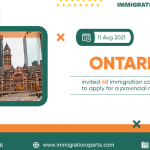Canada has always stood out as one of the most welcoming countries in the world for immigrants. Known for its multiculturalism, high quality of life, and steady economic growth, it has become a dream destination for people looking for better opportunities.
Over the last three years, Canada has witnessed record-breaking immigration numbers, surpassing even its own ambitious targets.
In this blog, we’ll look at how many immigrants Canada welcomed in 2022, 2023, and 2024, why the numbers have been so high, and what it means for the country’s future.
Immigration Numbers Over the Last 3 Years
2022 – The Year of Record Recovery
In 2022, Canada welcomed around 437,000 permanent residents, surpassing its target of 431,000. This was a historic milestone as it became the highest immigration intake ever recorded in Canadian history at that point.
The 2022 figure was especially significant because it followed the disruptions caused by the COVID-19 pandemic. The government focused on clearing backlogs and prioritizing economic immigration programs such as the Express Entry system and Provincial Nominee Programs (PNPs). The majority of new arrivals were skilled workers and international students transitioning to permanent residency.
2023 – Another Record Year
In 2023, Canada raised the bar even higher by admitting over 471,000 new permanent residents. This exceeded the official target of 465,000 and marked yet another all-time high.
What made 2023 special was the introduction of category-based draws under Express Entry. These targeted workers in healthcare, STEM fields, trades, transport, and agriculture. There was also a strong focus on French-speaking immigrants to support linguistic diversity across the provinces.
The strategy reflected Canada’s intention not just to increase numbers, but to make sure immigration supports specific labor market needs.
2024 – Pushing Beyond Limits
By 2024, Canada had once again outdone itself, with more than 483,000 immigrants gaining permanent residency. This was slightly above the government’s planned target of 485,000, showing how closely the actual numbers aligned with policy goals.
The growth highlighted Canada’s ongoing reliance on immigration to fuel its economy. However, it also sparked national debates on housing affordability, infrastructure, and resource availability. While immigration was essential to meet labor shortages, it became clear that managing settlement and integration services was equally important.
Why Canada’s Immigration Levels Are So High
The steady rise in immigration numbers is not random—it reflects Canada’s long-term national strategy. Some of the key drivers include:
- Labor Market Needs
With shortages in healthcare, skilled trades, transportation, and tech, Canada relies heavily on newcomers to fill critical roles. - Demographic Challenges
Canada’s population is aging rapidly, and birth rates remain low. Immigration helps sustain a balanced workforce and ensures that essential services like healthcare and pensions remain funded. - Economic Growth
Immigrants contribute as taxpayers, business owners, and consumers. They help drive GDP growth and keep Canada’s economy competitive on the global stage. - Global Appeal
Canada’s reputation as a safe, inclusive, and opportunity-rich country makes it a top choice for migrants compared to other destinations like the U.S. or Europe.
Benefits and Challenges of High Immigration
Benefits
- Stronger Workforce: A steady flow of skilled immigrants keeps industries growing.
- Cultural Diversity: Immigration enriches Canadian society with multiculturalism and innovation.
- Population Growth: Newcomers help balance Canada’s declining birth rate and sustain its long-term demographic health.
Challenges
- Housing Shortages: Demand for affordable housing has grown faster than supply.
- Infrastructure Strain: Healthcare, transportation, and education systems are feeling the pressure of rapid growth.
- Integration Needs: Newcomers often require settlement support, language training, and job-matching services to fully thrive.
Looking Ahead
Canada’s immigration numbers for the past three years—437,000 in 2022, 471,000 in 2023, and 483,000 in 2024—reflect a bold and ambitious strategy. However, policymakers are beginning to recognize that balancing immigration with infrastructure and housing supply is crucial.
From 2025 onwards, Canada is planning a gradual reduction in permanent resident targets, aiming for a more sustainable approach while still keeping immigration at globally high levels. For newcomers, this means opportunities will remain abundant, but competition could become more focused on specific skills and sectors.
Final Thoughts:
Immigration has been central to Canada’s growth story over the past three years. The rising numbers show the country’s commitment to building a vibrant and skilled society while staying globally competitive. At the same time, it highlights the importance of planning ahead—so that both newcomers and citizens can thrive together.
For anyone considering Canada as their future home, the past three years tell a clear story: this is a country that values talent, diversity, and opportunity.
Start your Canadian journey today—explore your best immigration pathway and secure your future with confidence!
Email: info@immigrationxperts.com
Call us: +91-9999467686, +91-8447-696555
FAQs About Canada’s Immigration Numbers
- How many immigrants came to Canada in 2022?
In 2022, Canada welcomed about 437,000 permanent residents, the highest ever recorded at that time, surpassing government targets. - How many new permanent residents did Canada admit in 2023?
In 2023, over 471,000 immigrants were admitted, setting yet another record and focusing heavily on economic class immigration. - What was Canada’s immigration number for 2024?
Canada admitted more than 483,000 immigrants in 2024, pushing beyond previous records and closely matching its official target. - Why does Canada admit so many immigrants every year?
Canada uses immigration to address labor shortages, support an aging population, and boost long-term economic growth. - Will Canada keep increasing immigration numbers?
Not indefinitely. While numbers were high between 2022–2024, future targets suggest a gradual decrease to balance growth with infrastructure and housing needs.






